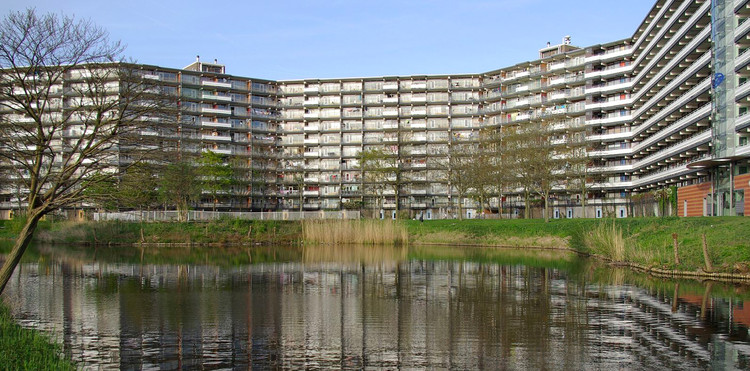
How can we plan a better city? The answer has confounded architects and urban planners since the birth of the industrial city. One attempt at answering came in the form of a spectacular modernist proposal outside of Amsterdam called the Bijlmermeer. And, as a new two-part episode by 99% Invisible reveals, it failed miserably. But, like all histories, the story is not as simple as it first appears.
In the post-war landscape of Europe, architects were provided with a platform to re-design cities from the ground up—linear, open, clean, and everything in its proper place. Thus the hexagonal-shaped scheme of the 6 square kilometer project separated actives and functions into their respective zones, restricting living to the sky and activity to the ground. The utopian and egalitarian ideals quickly dissolved as services drastically lagged behind construction. A delayed Metro line and almost non-existent amenities were only the beginning of the Bijlmermeer's troubles.
Soon, the massive complex of 31 buildings and 13,000 apartments became undesirable for the white middle class the project had been proposed for. Yet, the vacant apartments provided much-needed support for the influx of Surinamese migrants post-independence as well as those from Turkey, Morocco, and Ghana alongside queer people who faced challenges securing housing elsewhere. Vacant and underused spaces also became prime locations for heroin dealers and addicts who were pushed out of the city proper. The site was later labeled a ghetto.
But, unlike the inevitable destruction of Pruitt Igoe—Bijlmermeer's American counterpart—both residents and architects intervened into the existing structure to counter the site’s paternalistic modernity.
Learn more about how the Bijlmermeer went from “City of the Future” to “The Drain of the Dutch Society” to one of the most diverse areas in the Netherlands in 99% Invisible’s two part investigation here and here.
News via: 99% Invisible.
99% Invisible Recalls the Unknown Arts Awards of the Olympic Games
We've all heard of the record-breaking times, longest distances and of course, winners of those coveted medals, but according to 99% Invisible there is a lesser-known Olympic Games honor participants have received: awards in architecture.
99% Invisible Explores the Strange Phenomenon of Rotary Jails
99% Invisible has recently published a review of rotary jails, a strange prison architecture system in which cell blocks turn to align with the position of a single door, in the attempt to create better security. Used around the early 20 th century, this odd, carousel-like technology spread across the United States in mainly Midwestern towns.

